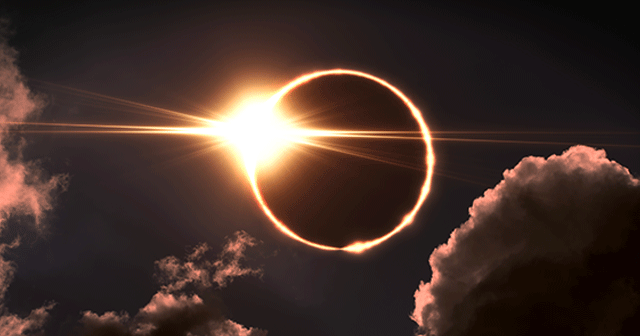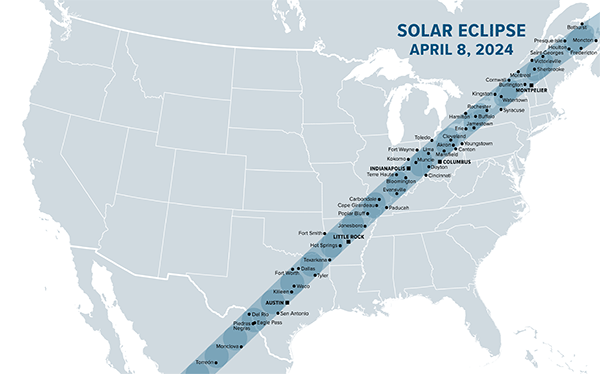Are There Any Business Impacts From the Total Eclipse?

The exciting solar eclipse will be hitting the U.S. on April 8, 2024. And if you are lucky enough to be within an approximately 170-mile wide strip of land stretching from Texas to Maine, you are in the path of a total solar eclipse. This type of event won’t happen again in the U.S. until 2044, so it’s no wonder many people are making travel plans to take in those few precious minutes of the sun totally eclipsed by the moon.
The “first contact” event begins at approximately 12:10 p.m. CDT, with a partial phase eclipse beginning in Eagle Pass, TX as the moon starts to cover the sun. The eclipse departs the U.S. through Grand Isle, Maine with the tail end of the partial phase completing at 4:41 p.m. EDT. If you are anywhere on the slightly curved “path of totality” stretching between those two states, check the schedule, because from start to finish the event only lasts a few hours. And even more elusive is the total eclipse, which only lasts a few seconds to a few minutes, depending on your location.
What to expect beyond a great view
In addition to the view, experiencing an eclipse can be just as unique. Darkness during the day is known to make farm animals agitated and birds quiet. And the weather can be affected by dramatic changes in sunlight in such a short period of time.
Some of the impacts:
Light Changes – the sky will begin to grow slightly darker until the total eclipse. This phased lead-in usually takes between 80-90 minutes, with subtle changes to the light as the total eclipse approaches. At the moment of total eclipse, a bright light like a diamond ring will appear. A total eclipse doesn’t make the sky black, but overall light drops dramatically.
Observers will feel a sudden drop in temperature similar to temperature changes just after sunset.
Temperature changes – observers will feel a sudden drop in temperature similar to temperature changes just after sunset. Temperatures can change rapidly during the event, with some historical records showing a drop of over 20 degrees F, although 10 degrees is more typical. Normal temps return fairly quickly once the eclipse begins to phase out.
Fun with shadows – shadow bands, an effect that causes stripes in shadows, and fuzzy edges will appear, as objects are distorted.
Wind – geography plays a role in the eclipse as elevations can create big discrepancies in temperature. Mountains and large hills in the path of the total eclipse will see their temperature drop and create a small cold front that can stream down the mountain or hillside, create cold winds that flow towards the flat areas. While there are no mountains in the path of this total eclipse, there should still be some impact.
Solar radiation – solar radiation will reach zero for those areas in the total eclipse. This impacts the ionosphere, the area of the sky several miles above the ground. Technically, electron density decreases. This is hardly noticeable for us on the ground, outside of some radio wave anomalies used for radio signals and GPS navigation. Small “holes” open up in the ionosphere and instead of reflecting radio waves, they actually escape the atmosphere.

Will there be impacts to business?
Businesses who look to weather as a factor in their business will keep an eye on the total eclipse. While a short event overall, such a sudden drop in sunlight does have an impact.
Researchers will be watching to see how the electrical grid is impacted, especially with the growing dependence on solar power.
The most impacted will be utilities. Power generation relies on solar resources which will see a significant dip. The U.S. electric grid has seen a steady increase in photovoltaic (PV) systems as the push for green energy has seen continued adoption of solar panel power generation. In 2017, the total eclipse that ran through the U.S. had several minutes where the power grid saw a decrease in 6 gigawatts of energy for approximately an hour*. Fortunately, this sudden drop did not affect the stability and reliability of the electric grid. Researchers will be watching to see how the electrical grid is impacted, especially with the growing dependence on solar power.
Overall, a total eclipse of the sun is a rare event that is on the bucket list for many people. If you are lucky enough to be in the path of the event, you will not only get a great view, but will see and feel some strange happenings. But fear not, these changes are only temporary and will last only a few second to a few minutes. Fortunately, this sudden drop will not affect the stability and reliability of the electric grid.
At DTN, providing operational insights into the energy sector is what we do. In fact, the DTN system has already been calibrated to consider the effects of the eclipse. We do this through implementation of an obscuration algorithm into our forecasts that calculate and account for the eclipse on incoming light and solar radiation. This is just one example of the variables our meteorologists use and is another example of how DTN continues to innovate and serve our customers. Our energy and utility weather expertise allows for the management of grid capacity through by having a clear understanding of weather impacts, even solar eclipses. Learn more about how DTN serves utility clients.
*Per NREL Research










 Comprehensive weather insights help safeguard your operations and drive confident decisions to make everyday mining operations as safe and efficient as possible.
Comprehensive weather insights help safeguard your operations and drive confident decisions to make everyday mining operations as safe and efficient as possible.

